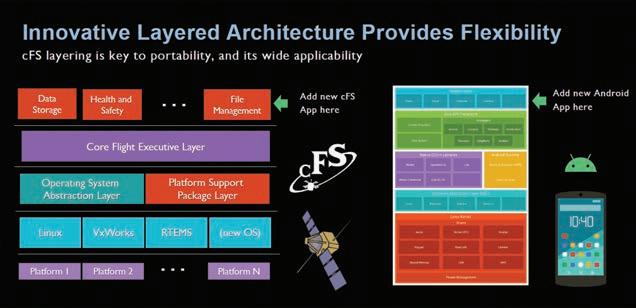
3 minute read
Goddard’s Core Flight Software Chosen for NASA’s Lunar Gateway
Experts at Goddard are building on award-winning core Flight System (cFS) foundations to help create and certify essenImage tial software for Artemis Gateway — a lunar orbiting platform — and make it available to other Artemis vehicles and systems.
Conceived in 2004, the open-sourced software has been improved internally and by suggestions from independent developers around the world. In July 2020, cFS was named NASA’s Software of the Year for its combination of “app store” delivery of solutions, stability, and adaptability.
“One of the really great things about core Flight System is that it’s always evolving,” said Jacob Hageman, team lead for the ongoing certification effort for Gateway. “And now with the Software of the Year Award, there’s a lot of interest. We work on maybe two or three missions a year, but outside of NASA, people are trying it out, finding new ways to use it, and making suggestions for improvement.”
Multiple NASA centers, industry partners, and international space agencies are developing Gateway. Goddard’s Exploration and Space Communications Projects Division’s technology and exploration offices and the Software Engineering Division are collaborating with NASA’s Johnson Space Center in Houston to certify cFS as Class A: suitable for human-rated vehicles.
“We’re working on making it easier to test, easier to trace requirements from mission applications and easier to adapt,” Hageman said. “The Artemis program has been providing resources to help us improve the product, and that benefits everyone who uses it.”
This flight software will be essential to Gateway’s day-to-day operations. It will act as the brains of the spacecraft, allowing all instruments and modules to operate properly while maintaining core functions under any circumstance.
Gateway is part of the Artemis program to return humans to the Moon, Mars, and beyond, and to establish a sustained lunar presence. Gateway will allow astronauts to live and work in lunar orbit and provide a waypoint for lunar exploration.
With humans aboard, every system on Gateway must be at a high standard that ensures astronaut safety. Class A certification assures that all of Gateway’s systems meet these rigorous requirements.
Heritage of Excellence
Gateway’s software builds on cFS’s dynamic development environment and component-based, adaptable design. Its flexible, layered architecture allows engineers to rapidly assemble a significant portion of a software system for new missions. This results in cost and time savings, as mission teams can avoid developing brand new software for each mission. NASA’s Artemis program sees such benefit in the cFS, that the core software is a requirement in the International Deep Space Interoperability Standards.
Jonathan Wilmot, a Goddard software architect, worked on cFS from the beginning, when he said the idea was born out of a need for efficiency. “We had two big missions in house at one time; we had the Solar Dynamics Observatory and we had Global Precipitation Measurement,” he said. “There wasn’t enough staff in house to do both independently, so we brought in all of the software people and the mission leads and established a set of requirements.”

Image credit: Jonathan Wilmot
This experienced team defined the software framework and application suite common to NASA missions so that future missions just had to add their mission-unique functions, Wilmot said.
As early as 2004, a team of Goddard developers envisioned an independent, reusable software framework for routine spacecraft tasks, including telemetry, health and safety and stored commanding (Tech Trends, Winter 2006, P. 5). In 2008, the Lunar Reconnaissance Orbiter (LRO) launched, operating on the core Flight Executive – a plug-and-play foundation for what would become cFS. The project continued under the leadership of Barbie Medina to implementation in 2010 (CuttingEdge, Winter 2010, P. 5). Since then, NASA has employed cFS on missions like the Lunar Atmosphere and Dust Environment Explorer (LADEE), Global Precipitation Measurement (GPM), the Magnetospheric Multiscale (MMS), and more.
Currently, the Goddard software development team is certifying the cFS by testing it to make sure it meets the requirements set forth by the agency. After testing at Goddard, it will be delivered to Johnson for additional testing, possible modifications for Gateway-specific features, and final implementation. The development team will use the data and feedback from an independent effort at Goddard to prove the value of a software testing technique called fuzzing (see article, Page 8).
CONTACT
Jacob.J.Hageman@nasa.gov or 301.286.1803






